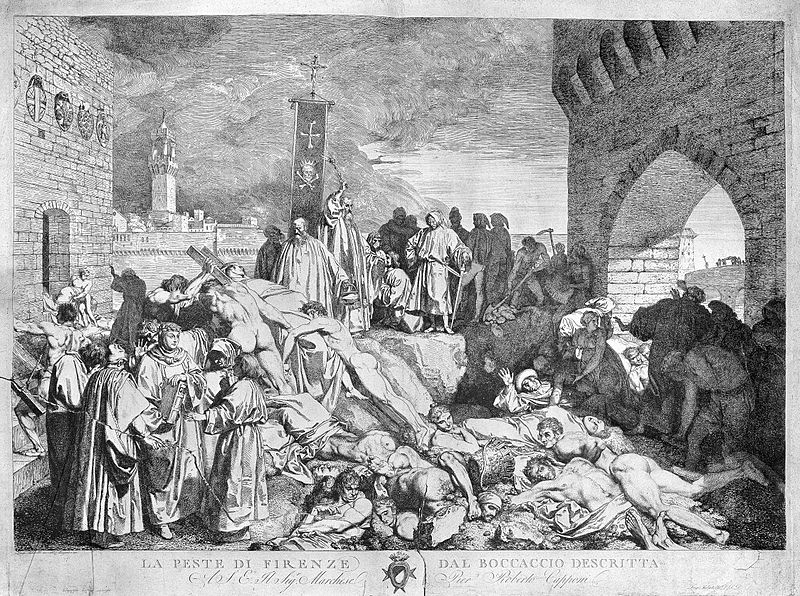21 July 2020
Debunked Myths about the Bubonic Plague
Posted by Shane Hanlon
This is part of a student blog series as part of the University of Pittsburgh’s Disease Ecology Class that our own Shane M Hanlon is currently teaching. Find out more about the series and read all the posts here!
By Pooja Gupta
The Black Death, believed to have been caused by infection with the bacterium Yersinia pestis, killed about 100 million people worldwide in the fourteenth century. However, there is still much that is unknown about this deadly disease, also known as the bubonic plague, and there are still myths about it that continue to be spread. Even though it wiped out a decent portion of Europe all those years ago, if someone were to contract the disease today it no longer means death thanks to modern medicine. To begin, the first myth about the disease revolves around its name. Many people assume that it was called the “Black Death” because it turned the flesh of its victims black. While the bubonic plague did cause some body parts to turn black as victims died, the term “Black Death” did not arise during the fourteenth century when the plague was occurring. The term was actually first coined in the sixteenth century by translators who were translating a fourteenth century poem by Simon de Covinus referencing the plague. He titled the poem “mors atra” which can be translated into “Black Death” or “Terrible Death” with the former being chosen by the translators for whatever reason. As the name was taken on by historians, it helped them distinguish the Bubonic Plague from the Great Plague of 1665 that occurred in England.

The plague of Florence in 1348. Credit: Wikipedia
A second myth is that the black death was a disease that primarily affected the poor. Even though the poor tended to be around fleas and rats which were vectors of the disease, the rich were just as affected. The poor died in greater numbers simply because their population greatly outnumbered that of the rich. Records show that many important knights, ladies, merchants, friaries and monasteries were just as affected by the plague as the rest of Europe. The plague also gave peasants newfound power because those who survived the plague believed that it was a blessing from god and put them above parliament. This led to a revolt in 1381 to fight against taxes imposed by parliament and also an employment shortage.
Another myth is that advancements in transportations increased the speed of the plague. The bubonic plague spread faster during the middle ages than bubonic plagues that travelled in the 20th century so advancements in transportation was not the cause. Scientists conducted experiments to track the speed of the plague that was occurring in the 20th century and found that it was travelling no faster than eight miles per year. The Black Death is believed to have travelled at a rate of a mile per day. Despite modern methods of transportation such as trains, cars and planes, the spread of the bubonic plague in the modern era was much slower than that of the medieval era. Some think this is due to better hygiene and medical treatment; however, this does not affect the spread of the plague. The plague was spread by rodents, and in the modern era it was rare to see rodents in a home and if it was, it was removed and dealt with immediately.
Lastly, another myth about the Black Death was that human efforts to stop its spread were useless. However, this is not the case as some cities were able to implement measures that saved large portions of their populations. One city in particular was Milan which walled up infected patients instead of bleeding them. If a person was infected with the plague, their entire house would be closed shut with bricks regardless if other individuals in the house were not infected. Sound a little familiar? This method of quarantining largely stopped the spread of the Plague in Milan as well as border patrols. It is interesting to see how methods used centuries ago are still being used today to stop the spread of our current pandemic. History tends to repeat itself as we have seen with various pandemics. However, it is up to us to see these recurring patterns and be proactive so that we may stop situations from becoming as deadly as they have the potential to be.
Sources: Human Efforts to Stop the Plague Were Not Useless


 The Plainspoken Scientist is the science communication blog of AGU’s Sharing Science program. With this blog, we wish to showcase creative and effective science communication via multiple mediums and modes.
The Plainspoken Scientist is the science communication blog of AGU’s Sharing Science program. With this blog, we wish to showcase creative and effective science communication via multiple mediums and modes.